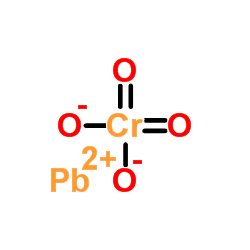Formula PbCrO4 Melting point 844 °C Appearance orange-yellow powder | Molar mass 323.2 g/mol Density 6.3 g/cm³ | |
 | ||
Lead(II) chromate (PbCrO4) is a chemical compound, a chromate of lead. It has a vivid yellow color and is insoluble in water, and as a result, is used in paints under the name chrome yellow.
Contents
Lead(II) chromate may also be known as chrome yellow, chromic acid lead(II) salt, canary chrome yellow 40-2250, chrome green, chrome green UC61, chrome green UC74, chrome green UC76, chrome lemon, crocoite, dianichi chrome yellow G, lemon yellow, king's yellow, Leipzig yellow, lemon yellow, Paris yellow, pigment green 15, plumbous chromate, pure lemon chrome L3GS, and various other names. The mineral crocoite, occurring as orange-yellow prismatic crystals, is a moderately rare mineral known from the oxidation zones of such Pb ore beds, that were affected by chromate-bearing solutions, coming from the oxidation of primary Cr minerals (chromite) of the nearby (ultra)mafic rocks.
Structure
Lead chromate adopts the monazite structure, meaning that the connectivity of the atoms is very similar to other compounds of the type MM'O4. Pb(II) has a distorted coordination sphere being surrounded by eight oxides with Pb-O distances ranging from 2.53 to 2.80 Å. The chromate anion is tetrahedral, as usual.
Applications
Approximately 37,000 tons were produced in 1996. The main applications are as a pigment in paints. It has also been used in the paint to color school buses.
Lead chromate is used in some pyrotechnic compositions, especially delay compositions, as an oxidizer.
Preparation
Lead(II) chromate can be produced by treating sodium chromate with lead salts such as lead(II) nitrate or by combining lead(II) monoxide with chromic acid. Related pigments are produced by the addition of sulfate, resulting in a mixed lead-chromate-sulfate compositions.
Reactions
Heating in hydroxide solution produces chrome red, a red or orange powder made by PbO and CrO3. Also, in hydroxide solution lead chromate slowly dissolves forming plumbite complex.
Safety hazards
Containing both lead and hexavalent chromium, lead chromate is treated with great care in its manufacture, the main concerns being dust. It is however so insoluble in water that neither the industrially produced or the naturally occurring mineral have been implicated in poisonings or cancer. Lead chromate is not used in consumer products, although in 1800s it was used to impart a bright yellow color to some types of candy.
Previously, its use was more widespread. Lead(II) chromate and "white lead", or lead(II) carbonate, were the most common lead-based paint pigments.
